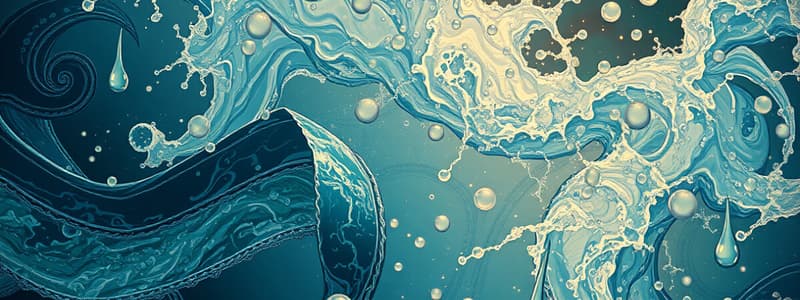Podcast
Questions and Answers
What process involves the direct change from solid to gas?
What process involves the direct change from solid to gas?
- Boiling
- Deposition
- Sublimation (correct)
- Evaporation
Boiling is a surface phenomenon.
Boiling is a surface phenomenon.
False (B)
What is the heat energy required to change 1 kg of a liquid to gas at its boiling point called?
What is the heat energy required to change 1 kg of a liquid to gas at its boiling point called?
Latent heat of vaporisation
The process of changing from gas to solid without going through the liquid state is called _____?
The process of changing from gas to solid without going through the liquid state is called _____?
Match the process with its definition:
Match the process with its definition:
Which of the following factors does NOT affect the rate of evaporation?
Which of the following factors does NOT affect the rate of evaporation?
What is the phenomenon called when a liquid changes into vapour below its boiling point?
What is the phenomenon called when a liquid changes into vapour below its boiling point?
Humidity refers to the absence of water vapour in the air.
Humidity refers to the absence of water vapour in the air.
How does an increase in wind speed affect the rate of evaporation?
How does an increase in wind speed affect the rate of evaporation?
The particles of liquid absorb __________ from the surrounding during evaporation.
The particles of liquid absorb __________ from the surrounding during evaporation.
Match the following states of matter with their properties:
Match the following states of matter with their properties:
Which of the following is a factor affecting the rate of evaporation?
Which of the following is a factor affecting the rate of evaporation?
Evaporation can occur at any temperature.
Evaporation can occur at any temperature.
What happens to the particles at the surface of a liquid during evaporation?
What happens to the particles at the surface of a liquid during evaporation?
At what temperature does water boil and begin to change from a liquid to a vapor?
At what temperature does water boil and begin to change from a liquid to a vapor?
The rate of evaporation decreases with an increase in surface area.
The rate of evaporation decreases with an increase in surface area.
What happens to water when it is left uncovered?
What happens to water when it is left uncovered?
The process by which a liquid changes into vapor without reaching the boiling point is called ______.
The process by which a liquid changes into vapor without reaching the boiling point is called ______.
Which of the following factors does NOT influence the rate of evaporation?
Which of the following factors does NOT influence the rate of evaporation?
Particles of matter are always at rest.
Particles of matter are always at rest.
Match the physical states of matter with their properties:
Match the physical states of matter with their properties:
What effect does an increase in temperature have on the particles in a liquid?
What effect does an increase in temperature have on the particles in a liquid?
Flashcards are hidden until you start studying
Study Notes
Physical State of Water
- At 250°C, water is in a gaseous state (steam).
- At 100°C, water can coexist in both liquid and gaseous states; it boils at this temperature.
Constant Temperature During Change of State
- Temperature remains constant during a change of state due to the energy being used to change the state rather than increasing temperature.
- Energy is absorbed or released during phase changes, maintaining constant temperature until the state transition is complete.
Factors Affecting Evaporation
- Surface Area: Increased surface area elevates the rate of evaporation as more particles are exposed to atmospheric conditions (e.g., spreading out wet clothes aids in drying).
- Temperature: Higher temperatures enhance kinetic energy of particles, allowing more of them to escape into the vapor state.
- Humidity: High humidity reduces evaporation rates because air is already saturated with water vapor, limiting additional evaporation.
- Wind Speed: Increased wind speed accelerates evaporation by removing water vapor from the area around evaporating surfaces, promoting further evaporation (e.g., clothes dry faster on windy days).
Evaporation and Cooling
- Evaporation is a cooling process; as liquid particles evaporate, they absorb energy, cooling the remaining liquid.
- For example, when water evaporates from a surface, the surface loses heat, leading to a cooling effect.
Key Concepts of Phase Changes
- Sublimation: Transition from solid directly to gas without becoming liquid (e.g., dry ice).
- Deposition: Transition from gas directly to solid without becoming liquid (e.g., frost formation).
- Boiling vs. Evaporation: Boiling is a bulk phenomenon occurring at the boiling point, whereas evaporation occurs at any temperature and involves only surface particles.
Heat Energy Concepts
- Latent Heat of Vaporization: Heat energy required to convert 1 kg of liquid to gas at its boiling point under atmospheric pressure.
- Latent Heat of Fusion: Heat energy needed to change 1 kg of solid to liquid at its melting point.
Kinetic Energy and Evaporation
- Liquids consist of particles with varying kinetic energy; only those with sufficient energy can escape liquid's surface to evaporate.
Experimental Observation
- Conducting activities (like placing water in a test tube near air flow) illustrates evaporation and cooling as surrounding energy is absorbed during the phase transition.
Studying That Suits You
Use AI to generate personalized quizzes and flashcards to suit your learning preferences.




